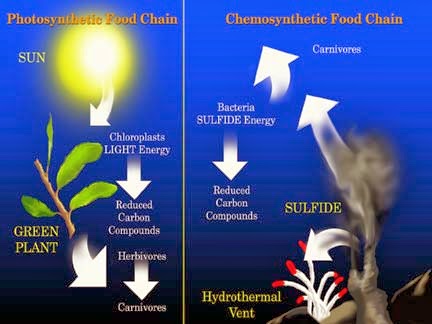CHEMOSYNTHESIS SPRING OF LIFE
Can Life survive without sun "Photosynthesis
" The Answer is "YES"
The Bible give the idea that there is life survived without sun photosythesis this process called the "Chemosynthesis"
"And God said, Let the earth bring forth grass, the herb yielding seed, and the fruit tree yielding fruit after his kind, whose seed is in itself, upon the earth: and it was so.And the earth brought forth grass, and herb yielding seed after his kind, and the tree yielding fruit, whose seed was in itself, after his kind: and God saw that it was good.And the evening and the morning were the third day.And God said, Let there be lights in the firmament of the heaven to divide the day from the night; and let them be for signs, and for seasons, and for days, and years:And let them be for lights in the firmament of the heaven to give light upon the earth: and it was so.And God made two great lights; the greater light to rule the day, and the lesser light to rule the night: he made the stars also.And God set them in the firmament of the heaven to give light upon the earth, And to rule over the day and over the night, and to divide the light from the darkness: and God saw that it was good.And the evening and the morning were the fourth day. [Gen.1:11-19]
In biochemistry, chemosynthesis is the biological conversion of one or more carbon molecules (usually carbon dioxide or methane) and nutrients into organic matter using the oxidation of inorganic molecules (e.g. hydrogen gas, hydrogen sulfide) or methane as a source of energy, rather than sunlight, as in photosynthesis. Chemoautotrophs, organisms that obtain carbon through chemosynthesis, are phylogenetically diverse, but groups that include conspicuous or biogeochemically-important taxa include the sulfur-oxidizing gamma and epsilon proteobacteria, theaquificaeles, the methanogenic archaea and the neutrophilic iron-oxidizing bacteria.
Many microorganisms in dark regions of the oceans also use chemosynthesis to produce biomass from single carbon molecules. Two categories can be distinguished. In the rare sites at which hydrogen molecules (H2) are available, the energy available from the reaction between CO2 and H2 (leading to production of methane, CH4) can be large enough to drive the production of biomass. Alternatively, in most oceanic environments, energy for chemosynthesis derives from reactions in which substances such as hydrogen sulfide or ammonia are oxidized. This may occur with or without the presence of oxygen.
Many chemosynthetic microorganisms are consumed by other organisms in the ocean, and symbiotic associations between chemosynthesizers and respiring heterotrophs are quite common. Large populations of animals can be supported by chemosynthetic secondary production at hydrothermal vents, methane clathrates, cold seeps, whale falls, and isolated cave water.

.jpg)



Comments
Post a Comment